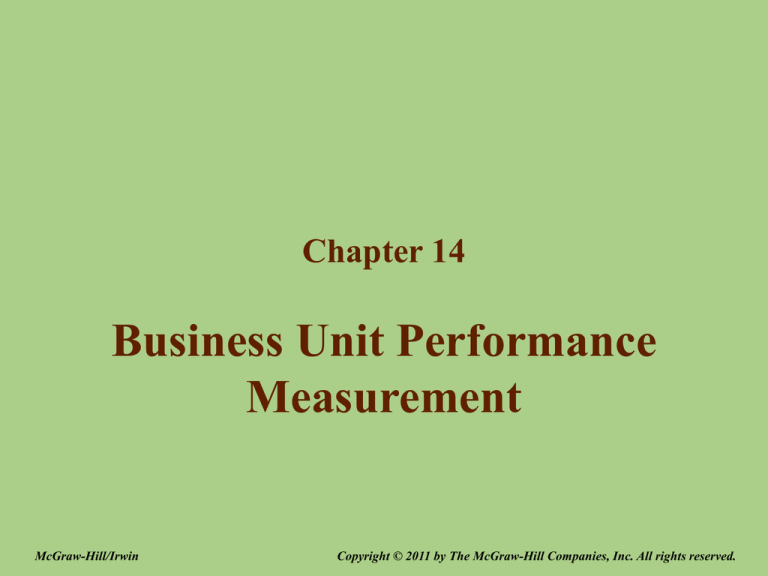
Chapter 14
Business Unit Performance
Measurement
McGraw-Hill/Irwin
Copyright © 2011 by The McGraw-Hill Companies, Inc. All rights reserved.
Accounting Income
L.O. 1 Evaluate divisional accounting income as a performance measure.
• Divisional Income:
Division revenues minus division costs
• Investors use accounting income to assess
a firm's performance.
• Firms use a division’s income to assess
divisional performance.
14 - 2
LO1
Divisional Income
Mustang Fashions
Divisional Income Statements
For Year 1 ($000)
Sales
Cost of sales
Gross margin
Allocated corporate overhead
Local advertising
Other general and administrative
Operating income
Tax expense (@ 30%)
After-tax income
Western
Division
Eastern
Division
Total
$5,200.0
2,802.0
$2,398.0
468.0
1,200.0
250.0
$ 480.0
144.0
$ 336.0
$2,800.0
1,515.0
$1,285.0
252.0
500.0
227.0
$ 306.0
91.8
$ 214.2
$8,000.0
4,317.0
$3,683.0
720.0
1,700.0
477.0
$ 786.0
235.8
$ 550.2
14 - 3
LO1
Some Simple Financial Ratios
Mustang Fashions
Selected Financial Ratios
For Year 1
Ratio
Definition
Western Eastern
Division Division
Gross margin percentage
Gross margin ÷ sales
46.12% 45.89%
Operating margin
Operating income ÷ Sales 9.23% 10.93%
Profit margin
After-tax income ÷ Sales
6.46% 7.65%
14 - 4
Return on Investment
L.O. 2 Interpret and use return on investment (ROI).
• Return on Investment (ROI):
Ratio of profits to investment in the asset that
generates those profits
• Provides a comparison of different size divisions.
14 - 5
LO2
Return on Investment
Mustang Fashions
Balance Sheets
January 1, Year 1
Assets
Cash
Accounts receivable
Inventory
Total current assets
Fixed assets (net)
Total assets
Liabilities and Equities
Accounts payable
Other current liabilities
Total current liabilities
Long-term debt
Total liabilities
Total shareholders equity
Total liabilities and equities
Western
Division
Eastern
Division
Total
$ 250,000
225,000
250,000
$ 725,000
775,000
$1,500,000
$ 150,000
250,000
150,000
$ 550,000
350,000
$ 900,000
$ 400,000
475,000
400,000
$1,275,000
1,125,000
$2,400,000
$ 125,000
227,000
$ 352,000
-0$ 352,000
1,148,000
$1,500,000
$
$ 220,000
507,000
$ 727,000
-0$ 727,000
1,673,000
$2,400,000
95,000
280,000
$ 375,000
-0$ 375,000
525,000
$ 900,000
14 - 6
LO2
Return on Investment
Mustang Fashions
ROI for Western and Eastern Divisions
For Year 1
Western
Division
After-tax income from income statement
Divisional investment from balance sheet
ROI (After-tax income ÷ Divisional investment)
Eastern
Division
$ 336,000 $ 214,200
$1,500,000 $ 900,000
22%
24%
14 - 7
Residual Income Measures
L.O. 3 Interpret and use residual income (RI).
• Residual Income (RI):
This is the excess of actual profit over
the cost of invested capital in the unit.
14 - 8
Economic Value Added (EVA)
L.O. 4 Interpret and use economic value added (EVA).
• EVA is the annual after-tax (adjusted)
divisional income minus the total annual
cost of (adjusted) capital.
• It makes adjustments to after-tax income and
capital to “eliminate accounting distortions.”
14 - 9
Measuring the Investment Base
L.O. 5 Explain how historical cost and net book value-based accounting
measures can be misleading in evaluating performance.
• Performance measures use divisional assets
or investments in the calculation.
• How should divisional assets be measured?
– Gross book value versus net book value
– Historical cost versus current cost
– Beginning, ending, or average balance
14 - 10
LO5
Gross Book Value versus
Net Book Value Example
• Profits before depreciation (all in cash flows at end of year):
$100 each year for 3 years
• Asset cost at beginning of year 1, $500
• Depreciation: Ten year life, straight-line, no salvage value
• Amounts are in thousand of dollars.
14 - 11
LO5
Year
Gross Book Value versus
Net Book Value Example
Net Book Value
1… ROI =
$100a – (0.1 × $500)b
$500d – (0.1 × $500)e
2… ROI =
$100a – (0.1 × $500)b
$450d – (0.1 × $500)e
3… ROI =
$100a – (0.1 × $500)b
$400d – (0.1 × $500)e
Gross Book Value
= 11.1%
$50c
ROI =
= 10%
$500
= 12.5%
$50c
ROI =
= 10%
$500
= 14.3%
$50c
ROI =
= 10%
$500
a
The first term in the numerator is the annual cash profit.
The second term in the numerator is depreciation for the year.
c Net income = $50 = $100 – ($500 × 0.1)
d The first term in the denominator is the beginning-of-the-year asset value.
e The second term in the denominator reduces the beginning-of-the-year
value of the asset by the amount of current year's depreciation
b
14 - 12
LO5
Historical Cost versus Current Cost
• Current cost:
Cost to replace or rebuild
an existing asset
• Historical cost:
Original cost to purchase
or build an asset
14 - 13
LO5
Historical Cost versus Current Cost
• Operating profits before depreciation
(all in cash flows at end of year):
Year 1, $100; Year 2, $120; Year 3, $144
• Annual rate of price changes is 20 percent.
• Asset cost at beginning of year 1 is $500.
• Straight-line depreciation is used;
the straight-line rate is 10% per year
• Amounts are in thousand of dollars.
14 - 14
LO5
Historical Cost versus Current Cost
Net Book Value
Year
Year
Historical Cost
$100a – (0.1 × $500)b
1… ROI =
= 11.1%
$500c – (0.1 × $500)
Current Cost
$100a – (0.1 × $600)b
1… ROI =
= 7.4%
$600d – (0.1 × $600)e
$120a – (0.1 × $500)b
2… ROI =
= 17.5%
$500c – (0.2 × $500)
$120a – (0.1 × $720)b
2… ROI =
= 8.3%
$720f – (0.2 × $720)e
$144a – (0.1 × $500)b
$144a – (0.1 × $864)b
=
26.9%
3…
ROI
=
= 9.5%
$500c – (0.3 × $500)
$864g – (0.3 × $864)e
Gross Book Value
Year
Historical Cost
Year
Current Cost
$100a – $50b
$100a – $60b
1… ROI =
= 10.0%
1… ROI =
= 6.7%
$500c
$600d
3… ROI =
2… ROI =
$120a – $50b
$500c
3… ROI =
$144a – $50b
$500c
= 14.0%
= 18.8%
2… ROI =
$120a – $72b
$720f
= 6.7%
3… ROI =
$144a – $86.4b
$864g
= 6.7%
a
Annual operating profit before depreciation. b Depreciation for the year.
Beginning-of-the-first-year value of the assets used in the investment base. d Current cost of asset ($500 × 120%)
e Accumulated depreciation at the end of the year. f Current cost of asset ($600 × 120%)
g Current cost of asset ($720 × 120%)
c
14 - 15
LO5
Beginning, Ending,
or Average Balance?
• Managers can manipulate purchases and
disposition based on which balance is
being used in evaluations.
14 - 16
LO1
End of Chapter 14
McGraw-Hill/Irwin
Copyright © 2011 by The McGraw-Hill Companies, Inc. All rights reserved.






